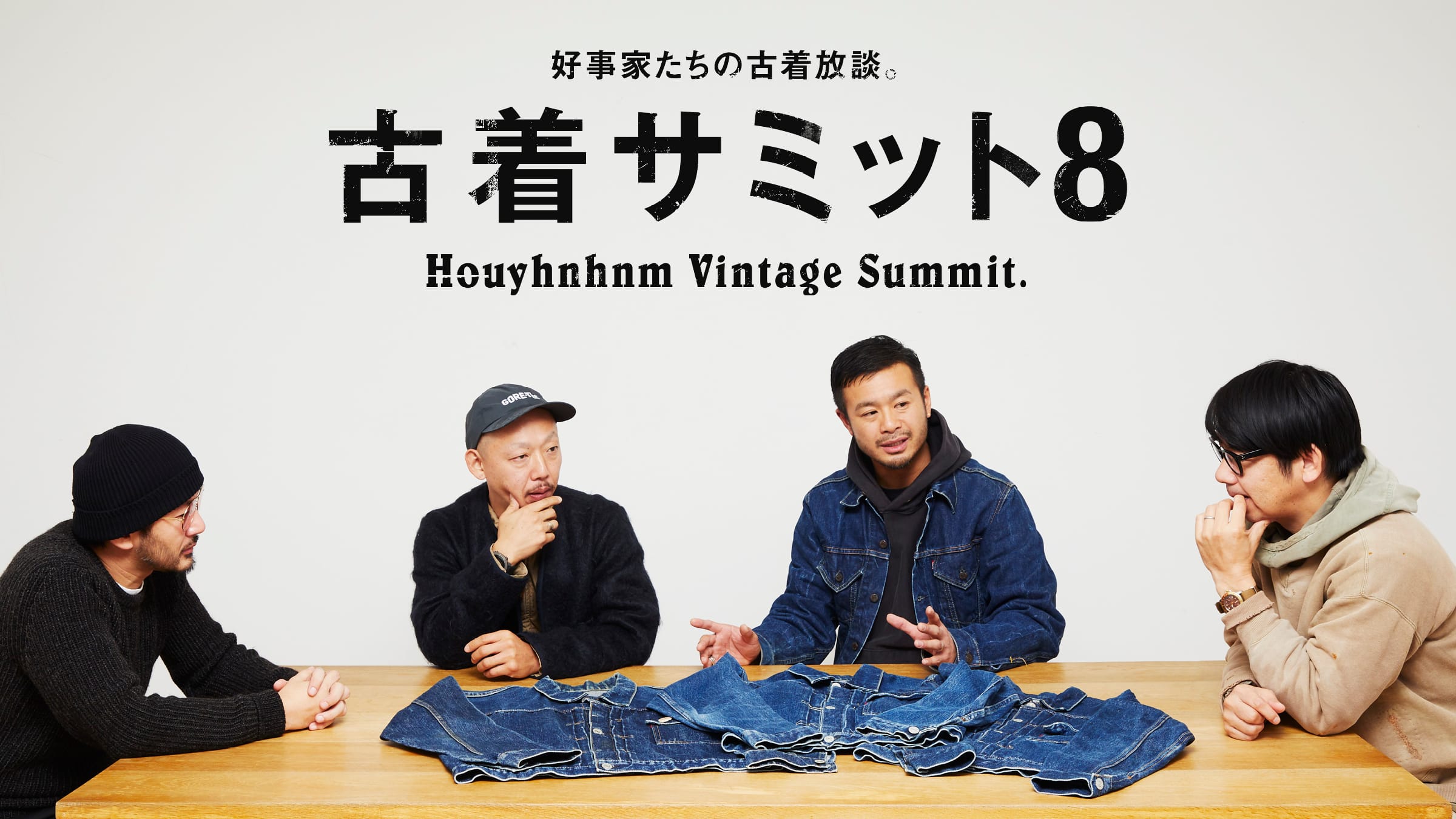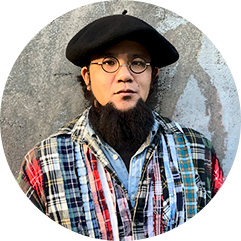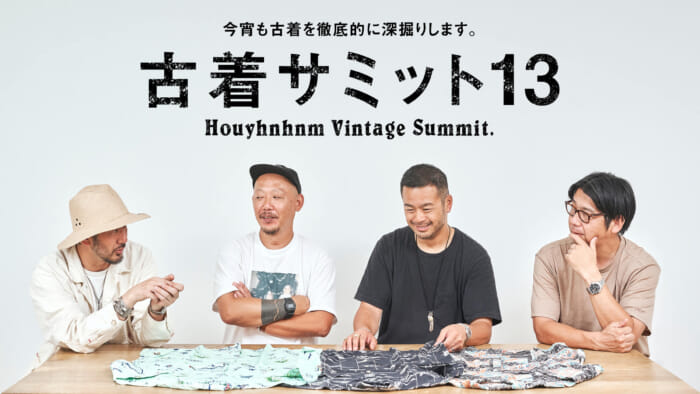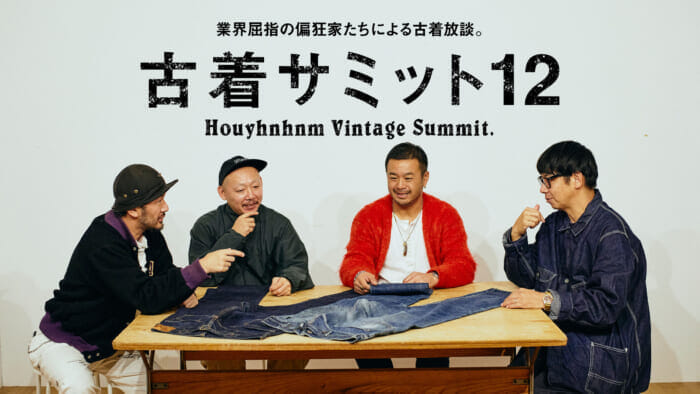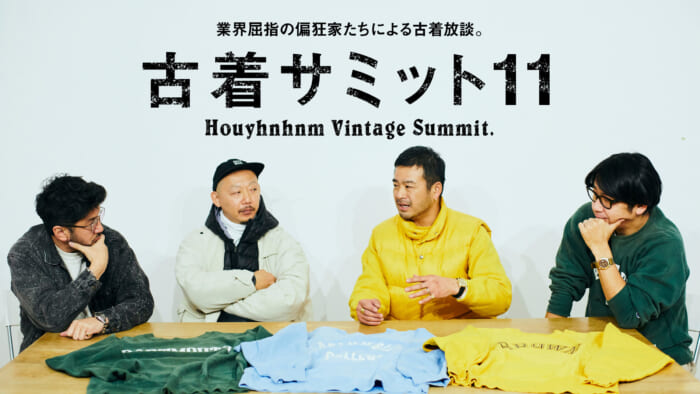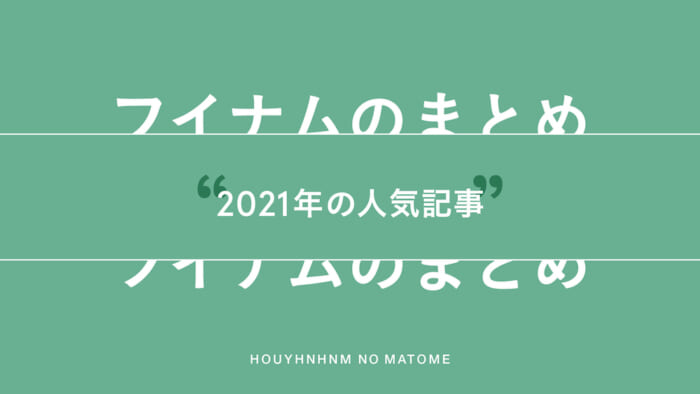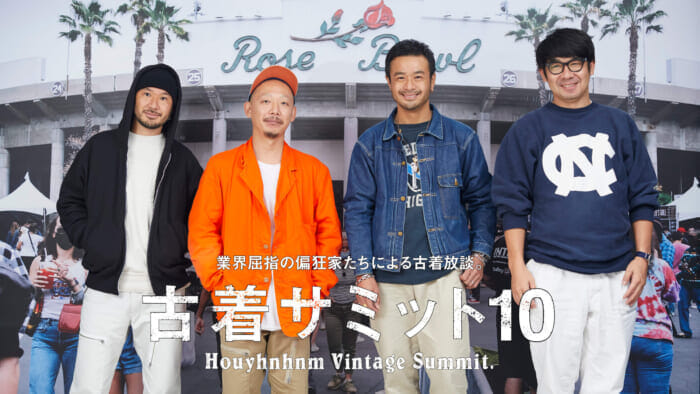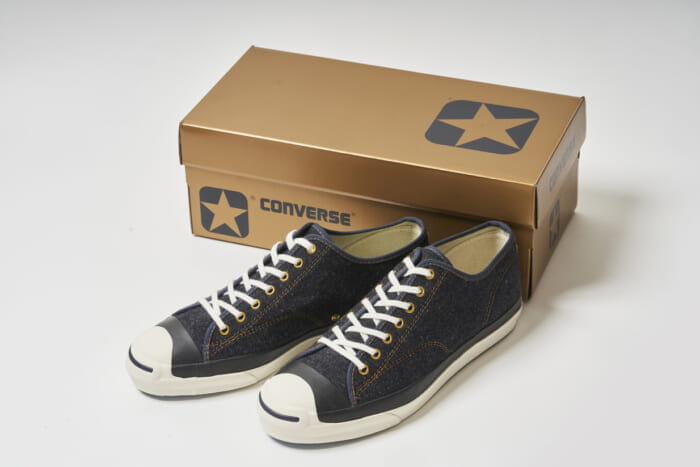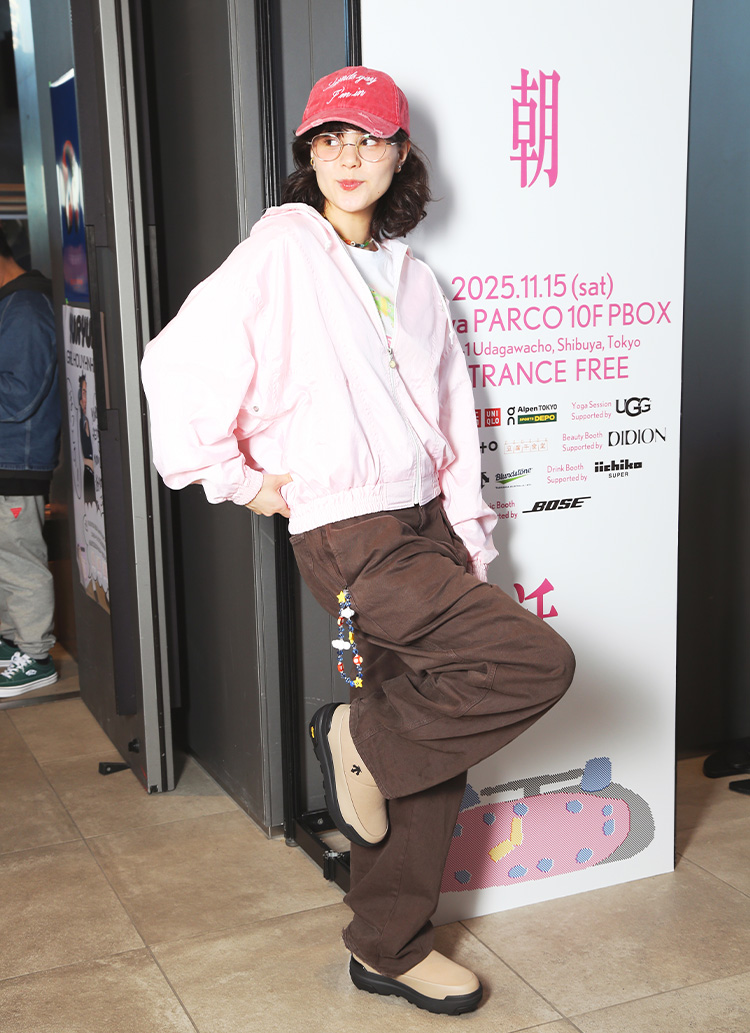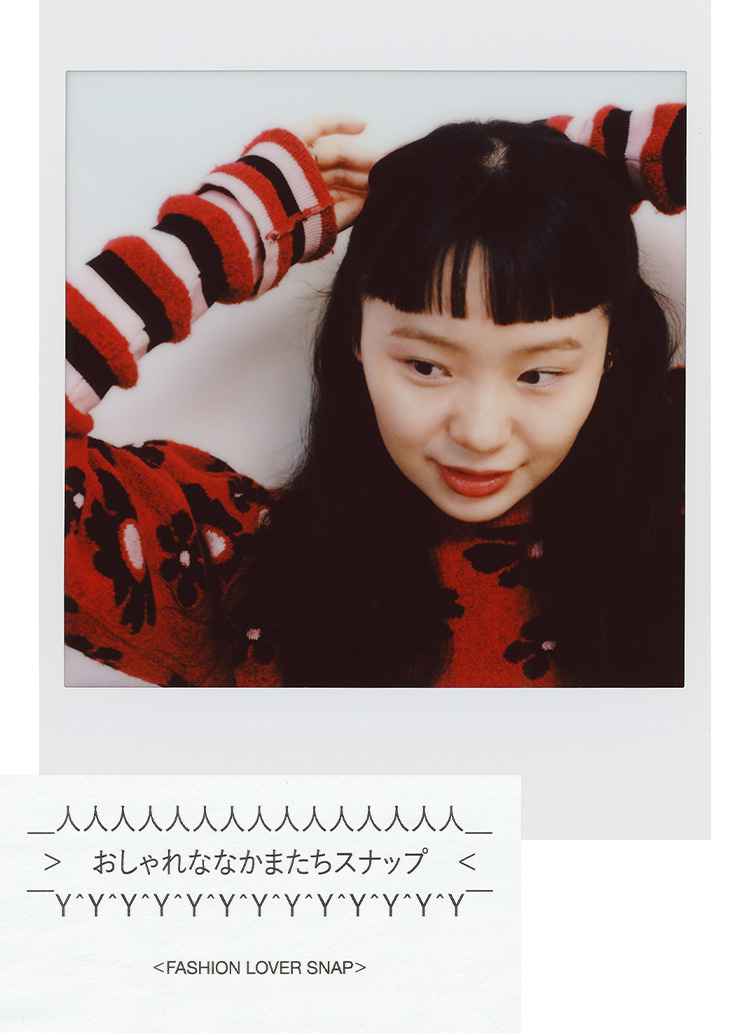Third lecture Fujihara Yutaka
The "Family Matching First.
I finally got a kid's size."

LEVI'S 506XX
Fujiwara:The first is the "506XX" denim jacket by Levi's, the so-called "first" denim jacket. I have three pieces, one for myself (left photo), one for my wife (center photo), and one for my son (right photo), so that we can wear them together as a family.
Abe:Family matching is awesome. It seems hard to find ladies and kids when firsts are so hard to find even for free. Are they all different ages?

Fujiwara:Yes, I have a few of them. As you can see from the cinch back, my son's jacket is the oldest, dating from the 1930s, followed by my own around 1941, and my wife's from 1947. The demand for denim jackets is growing so much that it would be safe to say that there is a G-jacket boom in our company (Berberzin). Especially when it comes to size 40 or over, the prices are very high.
Abe:Is it still as expensive as ever, especially for thongs (a detail unique to big sizes with the denim fabric joined in the center of the back)?

Fujiwara:That's right. Of course, it depends on the degree of color fading, but if the color is as dark as the one I brought today, it would cost about 2,000,000 yen.
Konno:2 million?

Fujiwara:Yes, we do. Recently, we have not been able to offer many thongs, or at any rate, there are only a few available. One of our regular customers bought one and showed it to me later. It was a particularly large size, over 50, and I think it was 54 or 56 or something.
Konno:Are some of them that big?
Fujiwara:The patch was missing, but it was probably marked "506XX EEE".
Konno:What size is "506XX E"?
Fujiwara:There are some slight differences depending on the age, but at this stage we believe that "506XX E" was 44-46, "506XX EE" 48-50, and perhaps "506XX EEE" was over 50 and also a special order.
Abe:Is the catalog only up to EE?
Fujiwara:Yes, it is. It's only listed up to 48 during the Great War and 50 after the war.

Kurihara:Unlike the third and later models, the first and second (507XX) models have pleats on the front. An American dealer I met the other day told me that there is a theory that in those days, the size was adjusted by cutting the stitches that hold these pleats in place.
Abe:Heh. I see.
Konno:That's why you see some broken pieces. It's true that it's just a single needle, and it only goes around once.
Fujiwara:I guess there is that theory, too. But personally, I prefer a complete product that is not cut off.
Kurihara:That's true, of course.
Fujiwara:As for this area, if the thread is broken or missing, it will definitely look like it was stitched afterwards, no matter how carefully the thread is selected and the stitching is aligned.
Kurihara:That's right.

Fujiwara:Well, anyway, whether it is the first or the second, they really don't come out these days, and even if they do, the prices are extraordinary, and I wonder if they will only go up in the future.
Abe:Konno and others are not so interested in this area?
Konno:I have two pieces of the World War II model. I've been wearing them for years, but I don't have any darker colors like Yutaka's, and I wouldn't touch them if they were a million dollars more expensive like they are now.
Kurihara:Well, yes... (laughs)
It's because G-jeans are in high demand right now,
We need to focus on more than just firsts and seconds."

LEVI'S 70505E & 71205E
Fujiwara:The second is a continuation of the G-jean, also by Levi's, with custom 70505 and 71205.
Abe:The "71205" is the long model of the "70505," right?
Fujiwara:Yes, I do. Longer lengths are easier to wear nowadays.
Kurihara:In the past, the "70505" was long, and its predecessor, the "557" (third), was shorter and better than the "70505", but the trend was that the longer length was easier to wear, and the "70505" is even longer, so we feel the times are changing.
Konno:Indeed. Well, maybe there will come a time when shorter is better again.


Abe:The badges are great, as well as the body. They all look like originals from that time.
Kurihara:It's rare for American taste to be mixed with something lame. ( lol ).
Fujiwara:Yes, it is. I think it's a little bit educational, because the stories are pornographic or drug-related, so it's a little hard to wear in front of children (laughs). On the other hand, chain-stitched items were usually priced at 100,000 yen in the 1990s, but recently they have become less popular and are easier to find. Well, there is no embroidery on the back, only on the front, so I choose one that is easy to wear.
Abe:Are you actually wearing it?
Fujiwara:Yes, I do. However, the set-up tends to be too tight in this area, so I try to choose a beautiful combination.

Abe:This area also seems to be more highly regarded in the U.S. than in Japan.
Kurihara:I guess so. In the U.S., most used clothing stores charge about $200 for a Big E, regardless of the color, and even now, embroidered ones are more highly rated. However, if you ask whether they sell at that price, they don't sell at all, and there are always some left over. For young dealers, it's a rare find, so I guess it can't be helped.
Abe:Are the long ones more expensive among them?
Fujiwara:Yes, it is. But that is among Japanese.

Kurihara:It's true that long hair is more popular in Japan.
Fujiwara:Well, above all, since G-jans are on the rise for the first time in a while, I wanted to focus not only on firsts and seconds that cost hundreds of thousands or millions of dollars, but also on this area.
The 501 with the devil's mustache was made by wearing it every day without washing it from dead stock.

501 66 MODEL
Fujiwara:The third one is also related to Levi's, and is the "501" 66 model. I got the lighter color used, but the darker color is a dead stock pair that I raised from scratch, from gluing to everything else, to see how the color would fade if I wore them every day.
Konno:It's what we call a moustache. How long have you been wearing it?

Fujiwara:It is 1 year and 7 months. The two pairs I brought today are exactly the same size, according to the description. The used ones have been washed and dried by the previous owner, but the ones I brought up have been worn every day, so on the contrary, the fabric has stretched and the overall size has increased.
Abe:I knew it would stretch if I wore it every day.
Fujiwara:Yes, I have a pair of jeans that are W34 in length and W35 in width. In the end, I washed it in boiling water, so it shrank a bit, but it was originally marked W34, but before washing it, it had stretched to W35.
Konno:You know, the days when sulfa (sulfide dyed) was applied?
Fujiwara:'74, but "501" was not adopted.
Konno:Then it must be growing because it's a raw machine. When was sulfa adopted?


Fujiwara:In the case of the "501", sulfa fabric was used from about 1976, and the color intensity changed. This is the reason why it is often said that the color fading is different between the early and late "66" models. Also, the "66" model had 6 buttons until the late '70s (the top button has a 6 engraved on the back), but sometimes 16 buttons can be found. I think this is more common around '75.
Kurihara:The colors are deeper and have a unique texture.
Abe:I know you like to wear them every day unless you are on vacation, but did you do anything special with them?
Fujiwara:I was riding a pisto bike to work, and I think I spilled some ramen noodles about twice when I was drunk.
Abe:Eh? What?
Fujiwara:Yes (laughter)
Kurihara:That's indeed a wash (laughs).
Fujiwara:No, no, as I said before, it was just a verification, and many of our regulars wanted to see the finished product.
Abe:Did the color still fade when I washed it?
Fujiwara:I used a detergent called "Beyondex" for vintage denim, which removed the dark spots and ramen stains well, but I don't think it did nearly enough to fade the indigo.
Abe:And you don't wear those jeans anymore?
Fujiwara:In a manner of speaking, as a result of the verification, it looks like it will be on display in the store for a while.

Abe:You know who wanted it?
Fujiwara:There were those who wanted to sell it for $200,000.
Konno:If it had been $250,000, you would have sold it.
Fujiwara:For 300,000 yen.
Konno:It's so realistic.
All:(Laughter)
YALE's reverse weave is deep with many variations."

CHAMPION REVERSE WEAVE YALE PRINTED
Fujiwara:Lastly, I brought "Reverse Weave" by "Champion," and also one '80s and one '90s from Yale University. I used to be the president of our company ("Champion").Vintage Summit 7(see "The Yale Collection") was collecting Yale stuff, so it was hard for me to get involved, but lately he doesn't seem to be interested in it much (laugh).
Abe:Do you mean Mr. Yamada's "Y"?
Fujiwara:I don't think that's the case, but in my case, it's the "Y" of Yutaka. However, once you start collecting them, they are hard to find. In addition to the one I have today, there is also a model called "Front Y" with the initials "Y" printed only on the front, but by the time I noticed it, the price had already risen to around 40,000 yen....

Abe:This one with YALE front and Y back sold for 240,000 yen on an auction site the other day.
Fujiwara:Well, that is indeed too expensive, but I guess people want it because the double-sided print of YALE on the front and Y on the back is only available on crew-neck sweatshirts and not on parkas.
Konno:Front Y, rear YALE, and vice versa, right?
Fujiwara:Popularity aside, I think that is more unusual.
Abe:Is that an irregularity?

Konno:Reverse weave has almost no difference in size between the front and back. So I think it was simply printed by mistake.
Abe:But I've also seen it in tataki (commonly known as tataki tags with the four sides of the tag sewn on).
Fujiwara:There were also some that only had back prints, which I also thought were misprints, as Konno said.
Kurihara:But in the case of post-attachment (aka post-attachment hoodies, where the hood is sewn onto the crew sweatshirt afterwards, rather than being integrated into the hood), there are many that only have a back print, aren't there? It is possible that some competitions had prints on the back of the sweatshirts so that they could be seen by spectators, for example.
Konno:I see.

Fujiwara:Also, there is a reversed version of this coloring (navy body + white stained print), and I would like to have that one if possible, but the price has gone up too high and I can't afford it.
Kurihara:However, we are not allowed to do this, of course, but it can be done by successfully reprinting on a plain, unprinted body, and I personally don't think it is worth several hundred thousand dollars.
Fujiwara:Well, you can do it if you want to.
Konno:I was told before that the runner's tag (a runner's tag that was used on non-reverse weave models before the transition to the commonly known Trico tag. In addition, there was a later type with a runner inside the C of the brand name), commonly known as the "Black Series," which was just a black body with the school's name printed in white.
Kurihara:You mean regardless of the College color, right?

Konno:Yes. It seems that all schools have only white prints on black bodies. I happened to have one of the Harvard prints from that series, and when I went to the U.S. wearing it, a dealer over there asked me if I collected them. I found out about it when I went to the U.S. wearing one of those Harvard pieces and was asked by a dealer there if I collected them.
Abe:Heh. I didn't know there was such a thing.
Konno:Yutaka, you should also look for Yale in the black series. According to the dealer, there is also a Yale.
Fujiwara:I see. I'll keep an eye out for it in the future.


